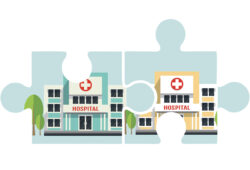Tools & advice to reduce the documentation burden

Electronic health records (EHRs) came into widespread use largely due to Meaningful Use guidelines that were implemented as part of 2009 legislation providing billions in government reimbursement to expand this effort. “At the time, nursing leaders only thought about putting more things in EHRs, not about how to take things out,” recalls task force member Sarah Michel, MBA, BSN, RN, NE-BC, former Director of Research and Clinical Engagement for HealthTrust. “By not having guiding principles and a process, we were simply adding elements that could take time away from patient care.”
Reducing the documentation burden in a core group of facilities helped alleviate that burden. “One of the positive impacts was increased patient satisfaction,” Michel notes. “If nurses have additional time outside of documentation, they can do more things for patients. And if patients are happier, typically nurses are happier.”
This perspective fuels Michel’s continued work as part of a national collaborative process to reduce documentation burden and improve data usability. She co-authored a March 2021 article in The Journal of Nursing Administration about creating a framework for the process to be replicated across other areas of a patient’s record within an EHR.
Getting started
The Admission History Task Force was created in 2018 as part of a national collaborative effort that began five years earlier, which evolved into the annual Nursing Knowledge Big Data Science (NKBDS) Conference. (See the Q3 2021 edition of The Source for background on the Task Force.) Workgroups met annually and virtually to address multiple nursing team priorities, including transforming documentation.

According to article co-author and Admission History Task Force Chair, Jane Englebright, Ph.D., RN, CENP, FAAN, and SVP and Chief Nurse Executive at HCA Healthcare, “Our goal was to create a reusable process for reducing documentation burden, and the Admission History Task Force was our first example.”
The process begins with following a set of guiding principles the task force devised to evaluate each data element. Any element that doesn’t meet the guiding principles should be eliminated. These guiding principles suggest that every data element is:
- Essential for patient care decisions, with a clear case for use of the data in care
- Addressing a regulatory requirement
- Evidence-based whenever possible
- Not documented elsewhere
- Best documented by a nurse
- Best documented during the admission process, as defined by an organization
- Making use of newly developed tools
The Admission History Task Force has generated three new tools to help organizations tackle the documentation burden. These include:
- NKBD Admission History Worksheet: This editable worksheet facilitates use of the Admission History Toolkit, optimizing the nursing admission history with a two-step process. Step 1 asks for entry of components of the current nursing admission history in the first column, where answering a yes-or-no question enables critical examination of the content. Components with at least one “yes” response are deemed essential components for the Nursing Admission Assessment. Step 2 uses a second table to enter the essential components identified by step 1.
- NKBD Admission Task Force Content: This Excel workbook provides recommended content for an admission history that minimizes documentation burden and maximizes discrete data available for reuse. The workbook also details items considered but not included, with the reasons for exclusion. It can be used in combination with the Toolkit to guide the generation or revision of admission history documentation.
- NKBD Admission History Toolkit: This guide for designing or remediating clinical documentation provides a step-by-step approach, offering pertinent tools and resources.
- The Toolkit uses the example of the admission history, but the process can also be used for other types of documentation.
“Having the required tools can jumpstart the process, and the tools are necessary for the direction in which standardization and workflow need to move,” Michel says. “I’ve spoken to staff at a few hospitals trying to get started in recent months, and some didn’t know where to begin. These types of resources are designed to help those stuck in the process and get them moving toward tackling the documentation burden with a standardized approach.”
Get started by accessing transformation documentation tools and related information. To volunteer for the work group, email nursingbigdata@umn.edu
Share Email EHR, Performance Improvement, Q4 2021, Standardization




